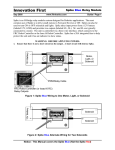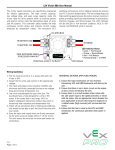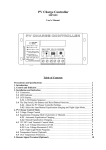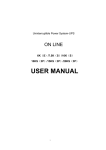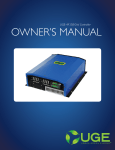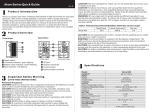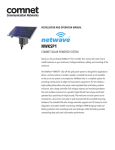Download Victor 884 User Manual
Transcript
12V Victor 884 IFIROBOTICS 25 Sept 06 Users Manual - Page 1 www.IFIrobotics.com The Victor speed controllers are specifically engineered for robotic applications. The high current capacity, low voltage drop, and peak surge capacity make the Victor ideal for drive systems while its braking options and precise control meet the demanding needs of arms and lift systems. This controller safely handles the high continuous current draws and extreme current surges produced by Competition robots. The innovative FET switching architecture and an integral cooling fan ensures cool FET junction temperatures. The low voltage drop and high switching speed ensures the motor receives maximum power, providing significant improvements in acceleration, direction changes, and lifting torque. The LED indicator will be GREEN in ‘full-forward’ condition, RED in ‘full-reverse’ and ORANGE while in neutral. Fan GND (BLK) BLK M GND BLK TO BATTERY GND TO MOTOR and TO MOTOR 30A BREAKER TO BATTERY 12V RED Fan 12V (RED) PWM EXTENSION CABLE TO RECEIVER PWM M 12 WRB Innovation First BC Brake/Coast Jumper VICTOR 884 Cal Button RED LED Indicator Status • Green = Full Forward • Orange = Neutral / Brake • Red = Full Reverse • Flashing Orange = no PWM LED Indicator Wiring Guidelines 1. The fan must be wired so it is always ON when the Victor is ON. 2. Attach the fan wires and connect to the appropriate voltage. the Victor. This will ensure the wires do not move and loosen the connections. WARNING: BEFORE APPLYING POWER: 3. The input and output wires should be 10AWG wire minimum and firmly connected to ensure low voltage drop and minimal temperature rise. 1. Ensure the input connections are not reversed. Connecting 12V and GND backwards will destroy the unit. 4. Use circle lugs designed for your wire size. The lug should have a hole designed for a #6 or #8 screw. If the center hole is too large, (#10 or larger) inadequate mechanical contact may result in excessively high resistance and temperature rise. 2. Ensure that there is not a short circuit on the output. A short circuit will destroy the unit. 3. Ensure there is a circuit breaker either inline with the 12V power input to the speed controller, or inline with the motor. Use an appropriate circuit breaker for your application to ensure that long term exposure to a stalled motor (high currents) will not overheat the Victor. 5. Check all lug connection after crimping and soldering. You should not be able to pull the lug off the wire with your hands. 6. Once the input and output wires are firmly connected, tie the wires using tie straps within 2” of 12V Victor 88 IFIROBOTICS 25 Sept 06 Users Manual - Page 2 www.IFIrobotics.com PWM Connection You will need (1) PWM extension cable or PWM Signal Driver. 1. Use a PWM Signal Driver to ensure the signal from your receiver is Victor compatible if you are not using an IFI Control System. 2. The male PWM cable connector connects to the speed controller. The Victor housing is design to provide a firm connection. Trim the shroud corners slightly if necessary for insertion into the Victor. 3. The PWM extension cable should be installed with the black wire towards the fan. 4. Standard Radio Controlled PWM connectors are fragile. Use caution when inserting and removing the PWM cable so the contacts on both connectors are not damaged. Mounting Guidelines You will need (2) #4 or #6 screws. 1. The Victor can be installed in any orientation. 2. The speed controller must have adequate space above the fan for airflow, a minimum of 2 inches. 3. Do not over-tighten the mounting screws through the speed controller. A snug connection will hold the speed controller in place without crushing the case. Calibration Instructions The Victor is pre-calibrated to values compatible with an IFI Control System and re-calibration is not needed. You can re-calibrate to achieve ‘full forward/reverse’ from your joystick movement if necessary. NOTE: While in calibration mode, the Victor will record the max PWM value detected as ‘full forward’, the min PWM value as ‘full reverse’, and ‘neutral’ will be the PWM value recorded at the release of the Cal button. The following steps will guide. 3. While continuing to hold the Cal button, move the joystick to the maximum and minimum positions. This can be done in any order and as many times as desired. 4. While continuing to hold the Cal button, return the joystick to center (neutral position). 5. Release the Cal button. 6. A flashing GREEN indicator confirms a successful calibration. 7. A flashing RED indicator denotes an unsuccessful calibration. An unsuccessful calibration occurs when either: a) Insufficient joystick travel was detected in forward and/or reverse. b) The trim tab is too far from center. Resetting Calibration to Factory Pre-calibration: 1. Power OFF the speed controller. 2. Press and hold the Cal button. 3. While continuing to hold the Cal button, Power ON the speed controller. 4. A flashing GREEN indicator denotes calibration is reset. Release the Cal button. Brake / Coast Configuration The Brake / Coast jumper is used to set the speed controller’s action during a neutral condition. The Brake provides significant resistance to motor rotation and is recommended for motors driving linkages and arms that can be back-driven by gravity or other external forces. The speed controller checks the status of the jumper approximately 60 times per second. This allows the user to change from brake to coast during operation. A limit switch may be connected to the jumper connector instead of the jumper. The limit switch can be triggered by various means including the use of a servo. Brake / Coast Guidelines: Reference Diagram 1. User Calibration: 1. 2. Power ON the speed controller. Press and hold the Cal button. After a moment, the LED indicator on the Victor will begin alternating between RED and GREEN to indicate a cal mode. 2. 3. The jumper should always be installed. If you lose the jumper, a standard computer jumper will work. The Coast condition (Jumper on Inner two Pins) sets the output to an open circuit during neutral. The Brake condition (Jumper on Outer two pins) sets the output to a short across the motor leads during neutral. IFIROBOTICS 25 Sept 06 www.IFIrobotics.com 12V Victor 884 Users Manual - Page 3 Troubleshooting Indication: No ORANGE indicator on power up. Problem: Input power issue or joystick trim tab off center. Possible Solutions: 1. Disconnect PWM cable. 2. If indicator blinks ORANGE, the PWM value that was being received is either between ‘neutral’ and ‘full forward’, or between ‘neutral’ and ‘full reverse’. Check joystick trim tab to ensure the controller is not in a partial forward or a partial reverse condition. If no change, check that the joystick and receiver channels match. 3. If indicator remains off, check +V or GND connections for voltage and proper polarity. Indication: Flashing ORANGE indicator on power up. Problem: No PWM signal. Possible Solutions: 1. Ensure the transmitter and receiver are powered ON. 2. The PWM cable may be improperly connected. Check wire color-coding at each end. Check that the connector is not off a pin at the receiver end. 3. Check for a good PWM signal by connecting a known good servo to the PWM extension cable. If the servo does not move, this can indicate either: a) a faulty receiver b) an improperly connected cable c) a bad PWM extension cable Note: The servo requires that 5V be present on the center pin of the PWM cable. This connection is not required for the Victor. Indication: Flashing RED indicator after calibration. Problem: Calibration Failed. Possible Solutions: 1. Inadequate travel in forward or reverse. Repeat the calibration procedure and move the joystick further forward and/or further reverse. 2. The joystick trim tab is NOT centered. Neutral cannot be extremely far from center. Indication: No power output from the speed controller although the indicator LED works. Problem: Possible internal damage. Possible Solutions: If the indicator on the Victor is operating properly and there is no output, the Victor may be internally damaged. This condition is typically caused by a short circuit on the output or there has been an over-current condition to caused a failure. Check the following: 1. Ensure the indicator is changing between ORANGE, RED and GREEN with joystick movement. 2. Disconnect the motor and check the output (M+ to M-) with a voltmeter. The meter should read between + Battery voltage with corresponding full range joystick movement. If the indicator is working properly and the outputs are not working properly, the speed controller is probably damaged. The final test to determine if the Victor is damaged is to replace it with another Victor. Indication: No power output from the speed controller and the indicator does NOT work. Problem: No input power or possible internal damage. Possible Solutions: If the indicator on the Victor is not operating properly and there is no output, the Victor may be internally damaged. This condition is typically caused by no input power or a reverse polarity on the input. Check the following: 1. Disconnect the output wires. 2. Ensure the indicator on the Victor will not illuminate at any joystick position. 3. Check the input at the Victor (+BATTERY to GND) with a voltmeter. If the indicator is not working properly and the input is good, the speed controller is probably damaged. The final test to determine if the Victor is damaged is to replace it with another Victor. CAUTION: Prior to replacing a potentially damaged speed controller, ensure that the wires connected to the output are not shorted and the input is not reversed. Also verify that neither of the motor output leads are shorted to the chassis of the motor and/or the robot. APPENDIX A: Document Version History Date Code 1-26-05 9-25-06 Changes Revised Brake/Coast Section Revised Brake/Coast Section Page 2




